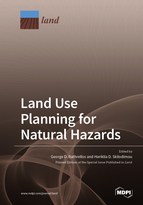Land Use Planning for Natural Hazards
A special issue of Land (ISSN 2073-445X).
Deadline for manuscript submissions: closed (30 April 2019) | Viewed by 47191
Special Issue Editors
Interests: natural hazards; urban planning; geomorphology; modeling
Special Issues, Collections and Topics in MDPI journals
Interests: GIS; geological mapping; environmental geology; natural hazards; land use planning
Special Issues, Collections and Topics in MDPI journals
Special Issue Information
Dear Colleagues,
The landscape of the Earth is the product of a complex evolution; it is the result of interactions involving surface progress, climate, tectonic and human activity. In this context, the morphological changes in landforms due to active tectonics or climate changes have the potential to affect and, in some cases, even to control human activities [1,2]. On the other hand, human activity and man-made constructions have the ability to change the landscape and as such have an impact on natural hazards.
Natural hazards are physical phenomena that occur worldwide and contribute to the evolution of the Earth’s landscape. Their associated consequences can lead to damage to both the natural and man-made environment [3]. When these consequences have a major impact on human life, natural hazards are called natural disasters.
On a global scale, overpopulation and urban development in areas prone to natural hazards increase the impact of natural disasters both in the developed and developing world. Generally, natural disasters occur more frequently in relation to our capability to restore the effects of past events [4].
Therefore, in order to minimize the loss of human life and reduce the economic consequences, proper planning, and management of natural disasters are essential. However, consideration of the natural hazards and their influence on landscape evolution during the land use planning stage is essential in natural hazard mitigation and urban disaster management.
For engineers, policy-makers and planners, it is important to employ land use planning based on natural hazard maps in the evaluation and selection of suitable areas for sustainable urban development with fundamental concern for the protection of the environment and of human life.
This Special Issue invites papers dealing with the interactions of natural hazards, human activities and land uses. Papers that address Natural Hazard Assessment Mapping and Land Uses are welcome.
- Bathrellos, G.D.; Gaki-Papanastassiou, K.; Skilodimou, H.D.; Papanastassiou, D.; Chousianitis, K.G. Potential suitability for urban planning and industry development by using natural hazard maps and geological-geomorphological parameters. Environmental Earth Sciences 2012, 66 (2), 537–548.
- Bathrellos, G.D.; Gaki-Papanastassiou, K.; Skilodimou, H.D.; Skianis, G.A.; Chousianitis, K.G. (). Assessment of rural community and agricultural development using geomorphological–geological factors and GIS in the Trikala prefecture (Central Greece). Stochastic Environmental Research and Risk Assessment 2013, 27 (2), 573–588.
- Bathrellos, G.D.; Skilodimou, H.D.; Chousianitis, K.; Youssef, A.M.; Pradhan, B. Suitability estimation for urban development using multi-hazard assessment map. Science of the Total Environment 2017, 575, 119–134.
- Guzzetti, F.; Carrara, A.; Cardinali, M.; Reichenbach, P. Landslide hazard evaluation: a review of current techniques and their application in a multi-scale study, Central Italy. Geomorphology 1999, 31, 181–216.
Dr. Hariklia D. Skilodimou
Guest Editors
Manuscript Submission Information
Manuscripts should be submitted online at www.mdpi.com by registering and logging in to this website. Once you are registered, click here to go to the submission form. Manuscripts can be submitted until the deadline. All submissions that pass pre-check are peer-reviewed. Accepted papers will be published continuously in the journal (as soon as accepted) and will be listed together on the special issue website. Research articles, review articles as well as short communications are invited. For planned papers, a title and short abstract (about 100 words) can be sent to the Editorial Office for announcement on this website.
Submitted manuscripts should not have been published previously, nor be under consideration for publication elsewhere (except conference proceedings papers). All manuscripts are thoroughly refereed through a single-blind peer-review process. A guide for authors and other relevant information for submission of manuscripts is available on the Instructions for Authors page. Land is an international peer-reviewed open access monthly journal published by MDPI.
Please visit the Instructions for Authors page before submitting a manuscript. The Article Processing Charge (APC) for publication in this open access journal is 2600 CHF (Swiss Francs). Submitted papers should be well formatted and use good English. Authors may use MDPI's English editing service prior to publication or during author revisions.
Keywords
- Land uses
- Climate changes and natural hazards
- Anthropogenic activities and natural hazards
- Natural hazard assessment models and maps
- Landscape evolution
- Urban and rural planning
- GIS and earth observation in natural hazards and land uses
- Hazard mitigation







